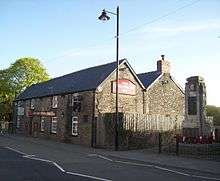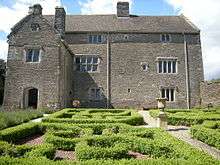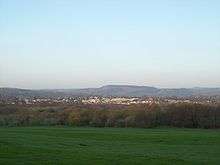Nelson, Caerphilly
| Nelson | |
 Nelson |
|
| Population | 4,647 (2011)[1] |
|---|---|
| OS grid reference | ST115995 |
| Principal area | Caerphilly |
| Ceremonial county | Gwent |
| Country | Wales |
| Sovereign state | United Kingdom |
| Post town | Treharris |
| Postcode district | CF46 |
| Dialling code | 01443 |
| Police | Gwent |
| Fire | South Wales |
| Ambulance | Welsh |
| EU Parliament | Wales |
| UK Parliament | Caerphilly |
| Welsh Assembly | Caerphilly |
|
|
Coordinates: 51°39′05″N 3°16′50″W / 51.6513°N 3.2806°W
Nelson (Welsh: Ffos y Gerddinen) is a village and community in the county borough of Caerphilly, Wales. It sits five miles north of Caerphilly and ten miles north of Cardiff, at the lower end of the Taff Bargoed Valley, and lies adjacent to Treharris, Trelewis and Quakers Yard.
History
Nelson was originally called Ffos-y-Gerddinen, a relatively flat piece of land at the southern extremity of the Taff Bargoed Valley to the south of the hamlet of Llancaiach. It existed on a drovers trail from the South Wales coast towards Merthyr Tydfil and onwards to Brecon and Mid Wales, where an enterprising man built a coaching inn that he called Nelson, possibly after Admiral Lord Nelson and his victory at the Battle of Trafalgar. Had it not been for the development of the South Wales coalfield, Nelson would have remained just a coaching inn surrounded by fields. When the Llancaiach Colliery was developed from 1811, it created a need for new housing for the workers and heavy transport for the coal, which spilled onto the flat lands below the colliery.

Freight transport from Merthyr Tydfil had already brought about the development of the Glamorganshire Canal which by-passed Nelson in the nearby Taff Valley, but in 1841 the Taff Vale Railway's Llancaiach Branch was built specifically to service Llancaiach Colliery and entered the Taff Bargoed Valley via the centre of Nelson. Looking for a name for its station, which was built on the flat land south of the colliery, the directors of the TVR chose the name of the coaching inn.[2] When the Taff Vale Extension railway of the Newport, Abergavenny and Hereford Railway was built, it replicated the TVR naming convention for its station, and Nelson was born as a village with a separate identity to Llancaiach.

Geography
Nelson is situated at 150 metres above sea level in a natural basin close to the confluence of the Taff and Taff Bargoed valleys, and the resultant relative flatness and surrounding fields are quite atypical of the steep sided valleys and linear villages associated with the area. To the south the land rises gently to the 383 metre summit of Mynydd Eglwysilan, which offers panoramic views of the Brecon Beacons, Bristol Channel and the coasts of Devon and Somerset.
To the east of the village lies Nelson Bog, a Site of Special Scientific Interest (SSSI). The bog is host to rare plants and wildlife including orchids, bats, badgers and otters.
Historically, Nelson lies within the county of Glamorgan, although boundary changes in 2003 merged the whole of Caerphilly County Borough with the preserved county of Gwent. The boundary with the county borough of Merthyr Tydfil runs along the northern edge of the village, while the border with Rhondda Cynon Taf passes a mile to the west. The hamlets of Llancaiach and Llanfabon lie to the north and south of Nelson respectively.
Buildings of note
Llancaiach Fawr is a 16th Century manor house which lies at the northern end of Nelson. The building is now a living history museum set in the year 1645 at height of the English Civil War, the year in which King Charles I visited the house in an attempt to persuade its owner, Colonel Edward Pritchard, not to switch allegiance to the Roundheads. In spite of this the colonel joined the Parliamentarian cause some time later. The manor is now reputed to be one of the most haunted buildings in Wales.
An open-air Pêl-Law court stands in the centre of the village and is believed to be the only operating Welsh handball court left in Wales.
Welsh Water's head office is in Nelson.
Sporting Clubs
Nelson is home to sports clubs; Nelson RFC, founded in 1934 and Nelson Cavaliers Football Club, founded in 1972. In 2001, rugby league team Valley Cougars were formed and now play in the Welsh Premier League.

Transport
Originally created as a result of transport needs for the Llancaiach Colliery, the Taff Vale Railway's Llancaiach Branch serviced only freight needs until the development of the Taff Vale Extension, which brought about the introduction of passenger services from 1862. Nelson's position as a junction station was increased after it was joined by a passenger and freight line to Dowlais on the Taff Bargoed branch which opened in 1876 and closed in 1964. Passenger services from Pontypridd were withdrawn along the Llancaiach Branch from 1932,[2] and the Taff Vale Extension from 1964 during the Beeching cuts. The station was demolished in 1972, but a very small part of the TVE Vale Of Neath line still exists to service the freight associated with coal extraction of the Ffos-y-fran Land Reclamation Scheme on the Taff Bargoed branch. Since the closure of its railway stations, the closest railway station to Nelson is two miles away at Ystrad Mynach.
Nelson lies one mile east of the A470 Abercynon roundabout, while the A472 trunk road bypasses the village. Bus services are provided by various companies and exist to the towns of Bargoed, Blackwood, Caerphilly, Merthyr Tydfil, Pontypridd, Treharris and Ystrad Mynach. The direct bus service to Cardiff was discontinued in 2009, with a change at Pontypridd now required.
Notable persons
Simon Weston OBE was born in Nelson in 1961, and is known throughout Britain as the soldier who suffered burns injuries during the Falklands War of 1982. He had been with the Welsh Guards since 1978, and on 8 June 1982 he was on board the RFA Sir Galahad just off the Falkland Islands when it was hit by enemy bombs. Weston survived with 46% burns.[3]
The current Lord Lieutenant for Mid Glamorgan, Kate Thomas, was brought up in Cardiff and educated at Cheltenham Ladies College before moving to Nelson where she settled into a farming life with her husband. She has previously held the offices of Vice Lord-Lieutenant and High Sheriff.
Robert Spragg (AKA Larry Love), the singer and songwriter from the band the Alabama 3 lived in Nelson before moving to London. His family moved to the village from Merthyr Tydfil and his parents still live there.
Sir Tasker Watkins VC GBE PC (1918–2007), was born in Nelson and was a recipient of the Victoria Cross, the highest and most prestigious award for gallantry in the face of the enemy that can be awarded to British and Commonwealth forces. He was successively a High Court judge, Lord Justice of Appeal and Deputy Lord Chief Justice of England. He was President of the Welsh Rugby Union from 1993 to 2004.
It is not certain exactly when Edward Prichard was born but we believe it to have been fairly early in the 17th century, possibly about 1610. Nor do we know where he was born for it is thought that the Prichard family had more than one house, although it is most likely that his birthplace was Llancaiach Fawr Manor.
Unfortunately little is known of his early life. He really came to prominence during the Civil War period. By this time he would have already married Mary Mansel (possibly in the 1630s), and his children probably would have been born – his two sons having “died young”. Much of this is supposition, as thus far few records for this period of his life have come to light.
What is certain is that he held the position of Sheriff of Glamorgan in 1638 and was appointed a Justice of the Peace in 1640, a post he held throughout the Civil War until his death in 1655.
Edward Prichard supported the Royalist cause until the second half of 1645, when, like most of the Welsh gentry, he changed his allegiance to the Parliamentarian side. It was late in this year that he was appointed Governor of Cardiff Castle. In February 1646 he staunchly held the Castle for the Parliamentarians against a siege headed by Edward Carne. He was also commended “for his constancy in that affray” after the battle of St Fagans (1648), by Colonel Horton, the Parliamentary victor.
Nelson photo gallery
-

Centre of Nelson
-

Shingrig Road
-

High Street
-

Cycle track passing Nelson
-

View of Nelson from Mynydd Eglwysilan
Location grid
 |
Treharris | Trelewis | Gelligaer |  |
| Quakers Yard | |
|||
| ||||
| | ||||
| Abercynon | Senghenydd | Ystrad Mynach |
References
- ↑ "Community population 2011". Retrieved 8 November 2015.
- 1 2 ""The Nelson branch" by Edward A. Evans. Pages 12-17". Backtrack 1996 Volume 10. Retrieved 2009-03-14.
- ↑ http://www.simonweston.com/
http://your.caerphilly.gov.uk/llancaiachfawr/
External links
- www.geograph.co.uk : photos of Nelson and surrounding area
- The 1881 Census for Nelson
- : Nelson Community Council official website
